Age of Mythology Showcase: Hades
Our monthly coverage of Age of Mythology continues with a look at the Greek god Hades.
See it in Action!
We are nearing the end of our ongoing Age of Mythology showcases. This month, we begin our seventh installment by considering the final Greek god in the game: Hades. As one of the famous trio of greater Greek gods, Hades is well known in Western culture, and he has even been popularized as a villain in a Disney film. He is, however, a humorless and gloomy god. Those who are familiar with Hades also know that he is the god of the dead. While not as popular as the other great gods of Greek mythology, his presence surpassed all powers save for the king of gods himself. In Age of Mythology, he is every bit as powerful as his siblings, Poseidon and Zeus.
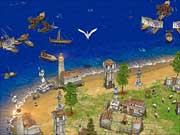
Greg Street, co-designer of Age of Mythology, gives us some historical background on this morbid divinity. "Hades is the Greek god of the dead," Street says. "There are two important things to remember about his empire, however. First, like Zeus and Poseidon, Hades didn't choose his realm. It was just luck of the draw. Second, Hades isn't the god of death, just the god of the dead. The point is that the Greeks did not view Hades as evil. He wasn't terribly nice, but then neither were Zeus and Hera. The Greeks viewed the dead with pity more than fear. Death could be punishment or reward, but it was also boring compared with the glory of life. While the Greek dead (usually called shades) may have been somewhat dull, the Greek underworld (usually and confusingly also called Hades), was not. It was full of flaming rivers, three-headed dogs, fields of gray flowers, and a prison for the Titans, those proto-gods that Zeus, Poseidon, and Hades usurped to claim rulership of the multiverse."
Hades wasn't a particularly popular Greek deity. And he did not feature prominently in as many tales as Zeus or Poseidon. But many heroes had to confront the great master of the dead. And in such instances, he was a terrifyingly unmovable entity. "Hades did not appear in Greek mythology to nearly the extent that his brothers did," Street says. "His principal stories involve his kidnapping his wife, Persephone, and the various myths in which some hero braves the underworld to ask Hades if he will release a friend of his (usually the answer is no)."
And just as several Greek myths delved into the underworld, so too will Age of Mythology's campaign feature a few underworld scenarios. Even better, the game will feature an underworld random map.
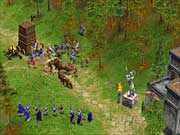
In Age of Mythology, Hades provides some interesting bonuses. In Greek mythology, he wasn't just the god of the dead, which means he has several other benefits to bestow on players. "Hades was also associated with wealth, since he lived underground and valuable minerals also came from underground (the Latin name for Hades was Pluto, from which we get "plutocracy," or rule by the wealthy)," Street explains. "We have interpreted his miserly instincts by making Hades more of a defensive god, with bonuses to building attack and defense, and by giving him strong archers, which nicely completes the Zeus-infantry and Poseidon-cavalry triangle."
Now let's take a close look at the actual civilization bonuses you'll get if you choose Hades as your god in Age of Mythology.
Hades Bonuses
Hades' emphasis on economy and defense mean he's best suited to a very different sort of player than Zeus or Poseidon. For those used to biding their time, hoarding resources, building defenses, and amassing a great army, Hades is the ideal god. And even as you hide behind improved defenses, you still have the reliable firepower of superior ranged units to surprise the enemy.
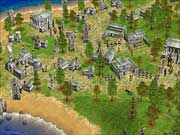
The immediate defensive benefit players will see when choosing Hades is sturdier buildings and deadlier defensive structures. All Hades' buildings start with bonus hit points, currently about 10 percent more hit points than the buildings of the other Greek gods. Of course, such stats are subject to change during play balancing. Also, any buildings with attacks, such as towers and the fortress, have stronger offensive capability, currently inflicting 20 percent more damage.
When you begin in the first age with Hades, you get immediate access to his god power, sentinel, which reinforces a Hades civilization's defensive superiority. Sentinel must be cast on your town center or an allied town center, and you must cast it on a completed town center, not an unclaimed settlement or a building under construction. Once completed, the sentinel power creates four animated statues around the center. Although the statues are immobile, they can fire arrows at any enemy units within range. Once summoned, sentinels are permanent. Moreover, they can benefit from building upgrades that improve hit points and attack power. Street says that in current play testing, sentinel is far more useful as an instant and reactive defense. "A lot of players cast it on their ally's town center, when it comes under attack," he says. "It is also useful when you are building new town centers in age three, particularly if those are near enemy bases. Because you can use the power so fast when you need it, there isn't a lot of motivation to use it right away."
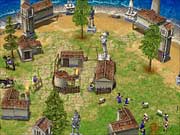
Of course, in addition to good defense, Hades also possesses superior ranged capability. As the best god for archers, Hades provides an immediate 10 percent damage bonus for all archer units. In addition, his choice of minor gods only serves to augment the efficiency of his archery range units.
Hades' association with money doesn't actually come across in a civilization bonus, but rather manifests itself in his mythological benefits (that is, god powers and minor gods). His myth technology provides an economic bonus, as does his choice of fourth age minor god. Says Street, "Hades' myth improvement ties into his love of wealth. Vaults of Erebus provides a steady income of gold for the rest of the game, even if your villagers are not actively working on gold." At this moment, vaults of Erebus contributes three gold every four seconds. It's a modest trickle, but still a significant boost, especially considering that you can derive the benefits of this technology as early as the first age. Moreover, the bonus is constant for Hades and can never be stolen from him by another player, unlike Hephaestus' plenty vault god power (more on this god power later).
Aside from his defense, archers, and wealth, Hades' best advantage is an obvious one involving the dead. Says Street, "Hades' most spectacular bonus is his shades." Anytime his soldiers die in battle, they have a modest chance of spawning as shades at the temple. This gives Hades the unique advantage of having dead units to complement his living army. Now we'll take a look at the shades, along with the other components of Hades' dreaded military.
The Armies of Hades
The shade is a unit that does not cost resources but occupies one population spot. Anytime a human soldier dies in battle, there is a 30 percent chance that it will spawn a shade at Hades' temple. The eligible units for spawning shades are any non-villager, non-ship, non-siege, and non-myth units. "Shades are reasonably powerful units, just below the level of a normal infantry," Street explains. "They do not gain the benefit of any armor or weapon upgrades, but they do get more hit points and attack automatically in later ages. They count as myth units, so they can be cleared out by heroes. Originally, the design of this feature had the shades spawning in combat, but we found that wasn't so useful. You would often not notice them. They would often appear in a place where they would get immediately killed. Sometimes there wasn't even room to spawn them. By tying the shades to the temple, Hades can manage them like normal soldiers--sending them out to combat where and when he sees fit."
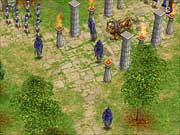
Shades ensure that a Hades player is tenacious and difficult to finish off, but the bulk of a Hades army will still be composed of normal (living) units. Chief among these units will be the archers. "In mirroring the other Greek unit lines, the archery range is available in the classical (second) age and provides toxotes," Street says. "The toxotes is the standard Age of Mythology archer, given that the Egyptians and Norse don't have a true foot archer. Toxotes are good against infantry and bad against cavalry. (There is no silent 'e' in ancient Greek, so the word is correctly pronounced 'toxotays.' Of course, hoplite is also correctly pronounced 'hoplitay,' but since everyone around Ensemble Studios and on the forums calls them 'hoplytes,' expect to hear a lot of 'toxohts.') Ancient Greeks put a lot of emphasis on archery as a sport and for hunting. They did use archers on the battlefield, but that position was without glory compared with fighting on the front lines with spear or sword."
As you advance to the heroic (third) age, you'll be able to recruit the peltast at the archery range. It's an antiarcher unit that is similar to the Age of Kings skirmisher. "Unlike skirmishers, peltasts and all Age of Mythology human soldiers cost gold," Street says. "Like all Greek soldiers, the peltast is more expensive and also more effective than the other counterarcher in the game, the Egyptian slinger. When balancing the game, we strive to let counterunits beat the things they are supposed to counter by a cost-effective margin of about 60 percent. So if you have an army of peltasts that costs 600 gold, they should be able to defeat 1,000 gold worth of similarly upgraded toxotes (or chariot archers). Natural counters, such as hippikon cavalry versus toxotes, should win by a 30 percent margin. It is neat and tidy with Greeks, but more complex with the Egyptian and Norse soldiers, who have less well-defined unit and counterunit roles. The Egyptian spearman, for example, is pretty good against cavalry and archers, but terrible against other infantry."
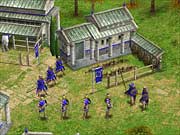
At the archery range, you can also research the medium, heavy, and champion archer improvements, much as you can do for the Greek infantry and cavalry at their respective buildings. Once researched, the archer improvements benefit all your archery range units, including both toxotes and peltasts. This is in contrast to the Norse (who have no archers to upgrade) and the Egyptians (who require separate upgrades for each unit type, rather than unit "class"). Greek archers can also benefit from improvements researched at the armory. Street singles out one upgrade, burning pitch, as a must-have. "Burning pitch in the mythic (fourth) age grants flaming arrows to toxotes and peltasts," he says. "Flaming arrows do extra damage to buildings, siege units, and ships (but not to human soldiers)." The extra fire damage allows a player to realistically assault buildings with archers alone, rather than needing the help of trebuchets and other siege weapons, as was the case in Age of Kings.
More of Hades' Units
As Hades is a Greek deity, he can also command powerful unique units and individual heroes. Both come from the fortress, which is available starting in the heroic age. It is the fourth in the Greeks' line of military buildings that includes the academy, archery range, and stables. Street describes the building: "The fortress is a mighty defensive building, trains special units, and provides all the Greek siege weapons. While the Egyptian migdol has a lot of hit points, the Greek fortress has a big attack. Remember, however, that Age of Kings spotlighted castles as one of the most recognizable icons of the medieval age. Age of Mythology fortresses are not Age of Kings castles. They are weaker, and at the same time, there are things like cyclopses and mountain giants stalking around that eat buildings for breakfast."
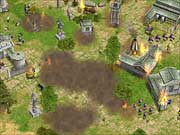
The Greeks have two siege weapons that are trained at the fortress: the petrobolos and the helepolis. The petrobolos, or stone thrower, is a heroic age catapult. "It is the earliest ranged siege weapon in the game, but it is not particularly powerful compared with mythic age siege weapons," Street says. "The helepolis is a mythic age siege tower and is quite powerful. 'Helepolis' literally means 'city destroyer' and was a singular tower used in the siege of Cyprus, over 150 feet high, manned by 200 soldiers, and bristling with catapults. The Greek helepolis is the most powerful siege weapon in the game, but it costs almost as much as the fortress that trains it. The two siege improvements (shared by Egyptians and Norse) are draft horses, which improves siege movement speed, and engineers, which improves siege damage."
Of course, the cool fortress units are the uniques and the heroes. Ensemble wants to ensure that the Greeks play similarly to the Age of Kings civilizations. So they are keeping several Age of Kings conventions in the game when you play as the Greeks, including one unique unit for each of the three major Greek gods. "These unique units are not as ubiquitous as their Age of Kings cousins, but they do give the Age of Mythology Greeks some nice, if expensive, options," Street explains. "Zeus' unit is the myrmidon, named after the antlike warriors of the hero Achilles. The myrmidon is an infantry with a bonus against foreigners (that is, non-Greek human soldiers). Poseidon's unit is the hetairoi, named after the elite cavalry of Alexander the Great. Hetairoi are weaker in combat than hippikon cavalry, but they have a bonus against buildings. Hades' unit is the gastraphetes ('gas-traf-a-teez'--no silent 'e,' remember), a word that means 'belly bow.' The gastraphetes was a primitive form of ballista (or a giant crossbow) that was carried and perhaps fired by being braced against the soldier's middle. Hades' gastraphetes have a long range and do extra damage against buildings, but fire and move slowly." The gastraphetes make good siege units, but are also effective against normal units as well, making them a good all-around ranged weapon for skirmishes and town sieges. But their slow rate of fire leaves them more vulnerable to speedy cavalry than regular archers.
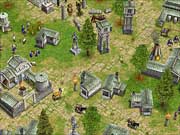
While you can recruit heroes in the town center, you can also do so at the fortress. Each Greek god commands four unique heroes that he does not share with his brothers. "Hades has four heroes, like the other Greeks," Street says. "Ajax, with his lion-headed helmet and door shield, is an archaic age infantry unit. Chiron is a centaur who can use his speed and ranged attack against enemy myth units. Mighty Achilles is the only cavalry hero in the game, and he is almost immune to arrow fire. In the mythic age comes perhaps the most potent Greek hero in the game, Perseus. Perseus was the slayer of the original Medusa, and the Age of Mythology unit still totes around her severed head, which he uses to petrify enemy myth units. Perseus is weaker than Polyphemus, and perhaps even Heracles, against normal soldiers, however." Each hero can hold his own against three to five regular infantry, although their strength really lies in tackling myth units. Ajax, for example, can only take down three infantry by himself. But he can also defeat two Nemean lions handily. Meanwhile, a Nemean lion can easily destroy six or more infantry. While heroes aren't very efficient against normal mortal units, because Greek heroes are so powerful, many players still upgrade them and use them side by side with regular troops.
Minor Gods
Since we have already covered Zeus and Poseidon, we've covered most of the Greek minor gods. The three we haven't discussed yet are Ares, Aphrodite, and Hephaestus, the minor gods for the classical, heroic, and mythic ages, respectively. All are available choices for Hades.
In the classical age, Ares becomes available. He was a god of war, like Athena, but he represented bloodlust and slaughter while she represented strategic, honorable warfare. Both competed intensely for Zeus' favor. But he can provide a great boost to the Hades player. His myth unit is the mighty cyclops, the most powerful myth unit in the classical age. While not as strong as the later age Norse giants, he is tough and can instantly kill units with his throwing power. Roughly every 15 seconds, he'll pick up a random unit (including horses and elephants but not myth units or siege weapons) and hurl it at nearby enemies. The thrown unit will die instantly, while all the other units hit suffer damage. While expensive, he is the best myth unit up to the classical age.
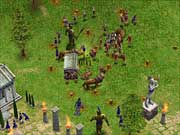
Ares' mythological improvements, of which he has four, benefit the attack power of military units (in contrast to Athena, who chooses to boost unit defense instead). Three of his mythological improvements are Phobos' spear of panic, Deimos' sword of dread, and Enyo's bow of horror. These upgrades improve the attack of hoplites, hypaspists, and toxotes by 10 percent, respectively. And because Ares' archers still benefit from archery range and armory upgrades, they are more powerful than other archers. Throw in Hades' archery bonus and you have the most devastating archers in the game. Ares' final mythological improvement is will of Kronos, which improves the attack power, hit points, and build speed of cyclopses.
Ares' god power is called pestilence, and it is an area-effect spell that halts all training of military units in the spell area. Military buildings, like fortresses and barracks, are shrouded in black flies and can't produce units while the spell is in effect. Town centers aren't affected. Says Street, "Pestilence is great to use just before a big assault, or to help out an ally who is being forward built on by pesky Norse."
The heroic age minor deity for Ares is Aphrodite, goddess of love. Street, however, says, "You don't have to read much about her to realize the Greeks weren't talking about filial love. (You can pretty much sum up the ancient Greek sexist views on women through their four main goddesses: Athena (the jock), Hera (the wench), Aphrodite (the sexpot), and Artemis (the man hater).) Aphrodite was supposed to be married to Hephaestus, but she engaged in many affairs with Ares and various attractive mortals. She never fought in combat, but persuaded others to fight for her. Therefore, her Age of Mythology god power is the non-aggressive curse, which turns enemies into swine, and her improvements benefit your economy."
Aphrodite's myth unit is the Nemean lion. It is a powerful melee unit twice as strong as a normal infantry unit that also periodically roars (about once every 15 seconds). The roar will instantly kill most unupgraded infantry and affects all units in a small area around the lion. One of Aphrodite's myth techs is called roar of Orthus and makes the lion nearly impervious to archer fire. Once researched, it makes Nemean lions awesome archer killers, but they are also fine complements for their own archers, as they can protect toxotes from enemy cavalry since they are high-speed, high-impact units. Aphrodite's other myth technologies are, according to Street, "Golden apples, which lets villagers gather favor faster (basically allowing Poseidon and Hades to have the Zeus rate), and divine blood, which lets villagers move and gather other resources faster." Aphrodite is a great addition to Hades if you want to really play up his wealth aspect but still have strong myth units.
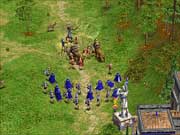
Aphrodite's god power, curse, isn't an earth-shattering blast, but it is still an inspiring piece of magic. "Curse simply turns a handful of enemy units into pigs," Street says. "Like any pig, these can be taken back and eaten, for the ultimate insult against your opponent. Despite the simplicity of this god power, it has proven one of the most popular in the game, both in testing and anytime we show the game off, like at E3."
The Final Age for the Greeks
The last Greek god to be revealed is Hephaestus, the deformed son of Zeus and Hera and the neglected husband of Aphrodite. He is the god of the forge, and was the smith for Olympus, crafting such finery as Zeus' deadly thunderbolts and Athena's fabled aegis shield.

Hephaestus' myth unit is the great colossus. "The colossus is a juggernaut of destruction," Street says. "He has high hit points, high attack power, and high armor, making him the closest thing the Greeks can get to a Norse giant. For purposes of comparison, the mountain giant has more hit points and attack power, while the colossus has more armor. While he doesn't erase buildings the way the mountain giant can, he does have a special ability to heal himself. The colossus is not a flesh-and-blood monster like many of the myth units; he is a construct. As such, as he can consume resources like gold and wood to heal himself." You must direct the colossus to eat trees or gold mines to heal himself. If he eats a tree, it is instantly devoured and he gains 200 hit points (about a fifth of his total). If he consumes gold, he heals one hit point per gold left in the mine. The healing itself is almost instantaneous.
The colossus can be further improved with two of Hephaestus' four mythological improvements. The hand of Talos increases the colossus' hit points 20 percent, while the shoulder of Talos adds another 20 percent hit point boost on top of that, and improves his armor as well. Says Street, "Talos was the original man of iron, also forged by Hephaestus, on whom the colossus was based. Only the Egyptian sphinx among myth units also has two upgrades." Hephaestus' other improvements are weapon of the titans, which boosts the attack strength of your unique fortress units (the myrmidon, hetaiori, and gastraphates), and forge of Olympus. Street explains the dilemma inherent in the forge of Olympus: "It is an interesting decision. It makes all of your armory improvements very cheap. However, since it comes late in the game, you have to decide if it is worth putting off those upgrades. We have play testers who never research this improvement and those who think it unbalances the game, which suggests that it probably works just about right."
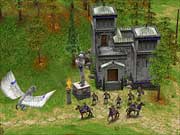
Once chosen, Hephaestus also provides his god power, called the plenty vault. It's right up the alley of the miserly Hades. When cast, the power creates an indestructible building that automatically gives food, wood, and gold to its owner for the rest of the game. It needs no villagers to work. It just magically gives you resources. The current rate (subject to change) is 10 of each resource (excluding favor) every five seconds. That's roughly equal to the output of six harvesting villagers. It's a great god power to have, but also one that must be guarded carefully. The plenty vault can't be attacked or destroyed, but it can be stolen. "If an enemy ever has more units near the plenty vault than you do (including buildings) then he or she will steal it and gain its benefit," Street explains. "Of course, you or an ally can always steal it back. Plenty may not have the flash of Artemis' earthquake, but it pays for itself over time, whereas earthquake lasts for less then a minute. If you have been chased back into your town, if the map is low on gold, if you are trying to build a wonder or feed allies, or if you just want a boost in your resources so you can focus on your military, it is a great power to have."
And with the summary of the forge god of Ancient Greece, we end our look at the Greek gods of Age of Mythology. Now, as we count down to our final showcase, we have two pantheons left. Next month, we return to the Egyptian mythology and uncover the secrets of Isis. She is perhaps the most versatile of any god in the game...
Got a news tip or want to contact us directly? Email news@gamespot.com
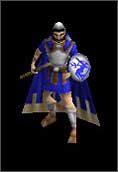
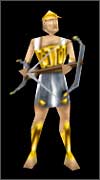
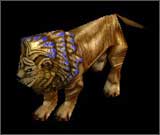
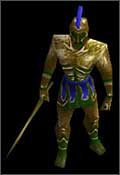
Join the conversation